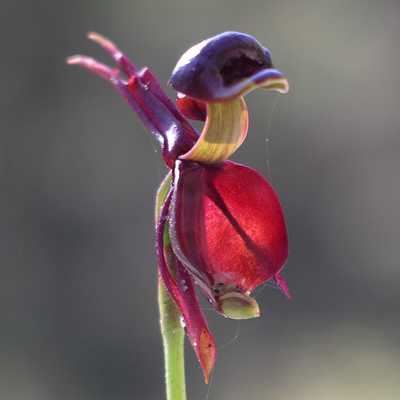
Bob Ross’ mention of the Flying Duck Orchid in the October 2018 issue of Native Plants for New South Wales reminded me of a piece I wrote some years ago for the Chefs Cap: newsletter of the Eurobodalla Regional Botanic Garden at Batemans Bay. This is an edited version.
There are many strange, interesting and beautiful ground orchids common on the NSW south coast, but none so delightful, appealing and downright cute as Caleana major, the Flying duck orchid.
I know a lady from Dalmeny who is fascinated by Australian orchids. She (and her husband and family) have spent many hours searching their local forests and grasslands for ground and epiphytic orchid species. Her orchid specimens are a valuable part of the Wallace Herbarium (ERBG) collection. The Bodalla Forest Park has been a favourite hunting ground for quite some time; in fact, she has written about her experiences there.
Early in October she phoned me with news of a colony of Flying duck orchids she and her husband had found just off the Princes Highway, opposite the entrance to Brou Tip (a bit north of Dalmeny). Never having seen this orchid in the flesh, so to speak, at first opportunity I hastened down the Highway to try and locate it. I had been given some pointers to follow, and in due course I found these. But in spite of an hour’s searching, no Flying ducks. Time had run out and I had to return home.
A phone call, asking for more directions. A few days later, I drove down to the tip area again. I was told that the orchids are rather small and grow in very dry, gravelly places, and that the first one is very difficult to find, but once the sightlines are established, others appear as if by magic. After another fruitless hour, I was thoroughly disgusted and on the point of going home, when I spied a single maroon orchid leaf in among fallen dry stringybark leaves. Suddenly, near the gravelly base of the tree (that had been left like a little hillock around the tree trunk after gravel had been removed from the site) I could see a little dark red/brown stem about 8cm tall with an orchid flower on top. Then there was another, and another, and another. I had found the Flying duck orchids!!
I was astonished at the delicate, intricate form of the flower; a form that is highly specialised to attract insects for pollination. The lower part is somewhat cup shaped and contains nectar, while above this and connected by a flat tensioned straplike appendage, is the ‘duck’ head that contains the pollination mechanism. When an insect lands on the cup – attracted by the nectar – the spring is activated and the ‘duck’ head snaps down, depositing pollen on the back of the insect. After a little while, the spring releases and the insect is free to fly away to another flower, thus transferring the pollen. The photograph, from Sydney Coast Walks, is a good illustration of the flower parts involved in this procedure. It is an amazing process, evolved over untold years, wonderfully simple, yet incredibly complicated.
I could not keep this find to myself, so I rang an acquaintance in Canberra who is interested in orchids. “I must see them”, she cried, and forthwith arranged to meet me at the spot the next weekend, postponing all her normal Saturday activities. Photographs were taken, and suitable expressions of wonder uttered. Others were shown the orchids, and these in turn showed their partners and friends.
All of these people shared my pleasure in these unusual and charming members of the fascinating world of plants.
